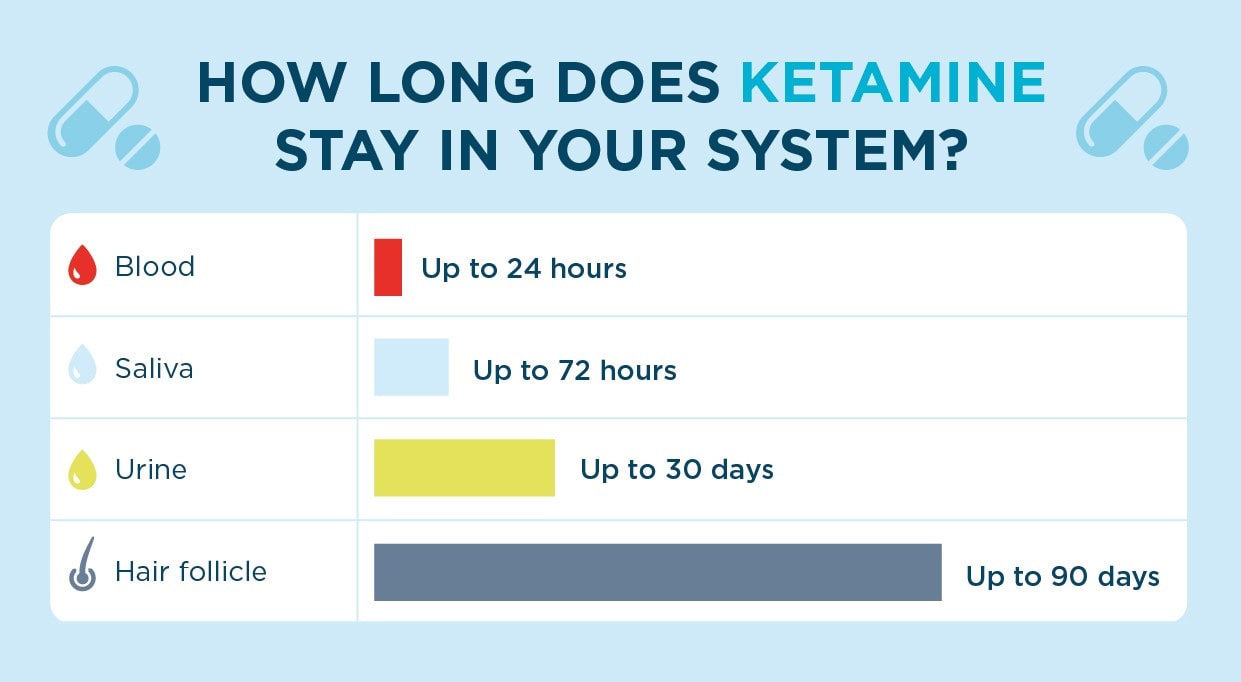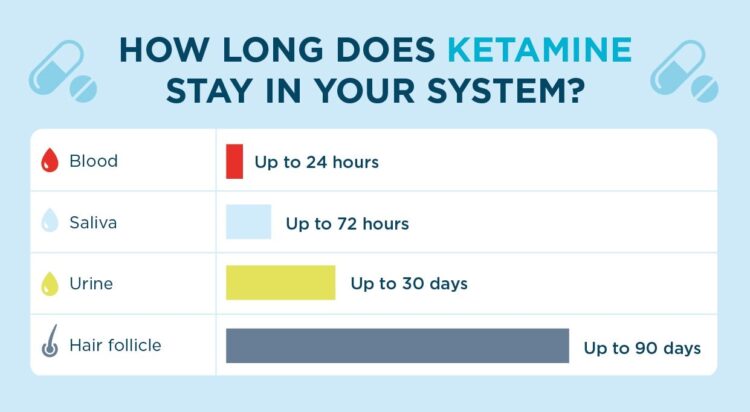
How long does ketamine stay in your system? This question is often asked by individuals concerned about the drug’s effects, potential detection, and implications for their health and well-being. Ketamine, a powerful anesthetic with dissociative properties, has gained attention for its medical uses and recreational use, leading to a growing need for understanding its pharmacokinetic profile.
The duration of ketamine in the body is influenced by several factors, including the dosage, route of administration, individual metabolism, and kidney function. This article explores the factors that determine how long ketamine remains detectable in the system, its effects on the body, and its use in medical settings.
Effects of Ketamine’s Duration on the Body: How Long Does Ketamine Stay In Your System

The duration of ketamine’s presence in the body can significantly influence its effects, ranging from short-term experiences to potential long-term consequences. Understanding the relationship between ketamine’s duration and its effects is crucial for making informed decisions about its use.
Potential Effects of Prolonged Ketamine Presence
The prolonged presence of ketamine in the system can lead to a range of effects, both short-term and long-term. While short-term effects are often associated with the initial “high” and subsequent “comedown,” long-term effects can be more complex and potentially harmful.
Short-Term Effects
- Dissociation: Ketamine is known for its dissociative properties, which can lead to feelings of detachment from reality, altered perception, and difficulty with cognitive tasks. These effects are typically more pronounced during the initial stages of ketamine use and can persist for several hours.
- Hallucinations: Some individuals may experience visual, auditory, or tactile hallucinations while under the influence of ketamine. These hallucinations can be vivid and realistic, adding to the overall dissociative experience.
- Amnesia: Ketamine can impair memory function, leading to periods of amnesia or difficulty recalling events that occurred while under the influence. This effect is particularly pronounced in cases of high doses or prolonged use.
- Cardiovascular Effects: Ketamine can increase heart rate and blood pressure, potentially leading to cardiovascular complications in individuals with pre-existing heart conditions. These effects are typically transient but can be exacerbated by high doses or repeated use.
- Respiratory Depression: While less common, ketamine can suppress breathing, especially at high doses. This effect can be dangerous and should be closely monitored, particularly in individuals with respiratory problems.
Long-Term Effects
- Tolerance and Dependence: Repeated ketamine use can lead to tolerance, where increasingly higher doses are needed to achieve the desired effects. This can progress to dependence, characterized by a strong craving for ketamine and withdrawal symptoms when use is discontinued.
- Cognitive Impairment: Long-term ketamine use has been linked to cognitive impairment, including problems with memory, attention, and decision-making. These effects can be persistent and may impact daily life.
- Mental Health Issues: Ketamine use has been associated with an increased risk of developing mental health problems, such as depression, anxiety, and psychosis. These effects can be particularly pronounced in individuals with a pre-existing vulnerability to mental illness.
- Bladder Problems: Long-term ketamine abuse can damage the bladder, leading to urinary incontinence, pain, and difficulty urinating. This is a serious complication that can require medical intervention.
- Liver Damage: Ketamine can be toxic to the liver, especially in cases of high doses or prolonged use. Liver damage can lead to a range of health problems, including jaundice, fatigue, and abdominal pain.
Ketamine Dependence and Withdrawal Symptoms, How long does ketamine stay in your system
Ketamine dependence can develop with repeated use, leading to a strong craving for the drug and withdrawal symptoms when use is discontinued. These symptoms can be unpleasant and may include:
- Depression: A common withdrawal symptom, characterized by feelings of sadness, hopelessness, and loss of interest in activities.
- Anxiety: Increased feelings of worry, nervousness, and restlessness, often accompanied by physical symptoms like sweating and rapid heartbeat.
- Insomnia: Difficulty falling asleep or staying asleep, leading to fatigue and irritability.
- Cravings: Intense urges to use ketamine, often accompanied by thoughts and memories related to past drug use.
- Physical Symptoms: Nausea, vomiting, diarrhea, muscle aches, and chills are common physical withdrawal symptoms.
Ketamine’s Duration and Effects on Mental State
Ketamine’s duration in the system directly impacts its effects on mental state. The dissociative and hallucinatory effects are most pronounced during the initial stages of ketamine use, when the drug is at its peak concentration in the bloodstream. As ketamine levels decline, these effects gradually subside, but residual effects like altered perception and cognitive impairment can persist for several hours.
Dissociation and Altered Perception
- Feelings of Detachment: Ketamine induces a sense of detachment from reality, leading to feelings of being outside of one’s body or observing oneself from a distance.
- Distorted Perception: Ketamine alters sensory perception, leading to changes in how individuals experience sight, sound, touch, taste, and smell.
- Difficulty with Cognitive Tasks: Ketamine impairs cognitive function, making it difficult to concentrate, think clearly, and make decisions.
Hallucinations
- Visual Hallucinations: Ketamine can induce visual hallucinations, including seeing shapes, patterns, or objects that are not actually present.
- Auditory Hallucinations: Ketamine can also cause auditory hallucinations, such as hearing voices, music, or other sounds that are not real.
- Tactile Hallucinations: Less common, ketamine can sometimes lead to tactile hallucinations, where individuals feel sensations like tingling, burning, or pressure on their skin.
Ketamine’s Use in Medical and Therapeutic Settings

Ketamine, a powerful anesthetic, has emerged as a versatile medication with a range of applications in medical and therapeutic settings. Initially known for its rapid anesthetic effects, ketamine has gained recognition for its potential in pain management and even the treatment of depression. This section delves into the various uses of ketamine in medical contexts, exploring its benefits, risks, and the ethical considerations surrounding its application.
Applications in Anesthesia
Ketamine’s anesthetic properties make it a valuable tool in various medical procedures. It is particularly useful in situations where traditional anesthetics may not be suitable, such as in patients with compromised respiratory function or those undergoing emergency procedures. Its rapid onset of action and ability to maintain hemodynamic stability make it a preferred choice in certain cases.
Pain Management
Ketamine has demonstrated efficacy in managing acute and chronic pain, particularly neuropathic pain, which is often resistant to conventional analgesics. Its unique mechanism of action, involving the modulation of N-methyl-D-aspartate (NMDA) receptors in the central nervous system, allows it to provide pain relief even in cases where other medications have failed.
Depression Treatment
The use of ketamine in treating depression has gained significant attention in recent years. Studies have shown that intravenous ketamine infusions can induce rapid and sustained antidepressant effects in patients with treatment-resistant depression. This breakthrough has opened new avenues for addressing this debilitating condition, offering hope to individuals who have not responded to traditional antidepressants.
Ethical Considerations
The use of ketamine in therapeutic contexts, particularly in cases where prolonged exposure may be required, raises ethical concerns. The potential for abuse and dependence, along with the need for careful monitoring, necessitates a cautious approach to its therapeutic application. Ensuring informed consent, proper patient selection, and comprehensive risk-benefit assessments are crucial to mitigate potential ethical dilemmas.
Risks and Benefits
While ketamine offers significant therapeutic benefits, it is essential to acknowledge its potential risks. Common side effects include nausea, vomiting, dizziness, and hallucinations. In some cases, ketamine can induce dissociative states, characterized by altered perception and a feeling of detachment from reality. However, these effects are generally transient and subside within a few hours.
Proper monitoring and patient education are crucial to minimize risks and maximize the benefits of ketamine therapy.
Last Recap

Understanding the pharmacokinetic profile of ketamine is crucial for both medical professionals and individuals considering its use. The duration of ketamine in the system can vary depending on several factors, and it’s important to be aware of its potential effects and risks. Whether for medical purposes or recreational use, responsible and informed decision-making is essential.
Helpful Answers
Can ketamine be detected in a drug test?
Yes, ketamine can be detected in urine, blood, and hair samples. The detection window varies depending on the testing method and the individual’s usage.
How long does ketamine stay in your system after a single use?
The duration of ketamine in the system after a single use can range from a few hours to several days, depending on factors like dosage, metabolism, and kidney function.
What are the signs of ketamine withdrawal?
Ketamine withdrawal symptoms can include anxiety, insomnia, depression, and cravings. Severe withdrawal can lead to seizures and delirium.
Is ketamine safe to use recreationally?
Recreational use of ketamine carries risks, including potential for addiction, overdose, and psychological effects. It’s crucial to use it responsibly and in moderation.





